Mammals have existed for 170-225 million years and some ancient mammals that lived alongside dinosaurs were called mammaliaforms. The defining differences between the terms are fuzzy so we’re including examples of both on our list. What are 11 ancient mammals that lived alongside dinosaurs?
A mass extinction event took out all non-avian dinosaurs around 66 million years ago. Small mammals managed to survive while larger ancient mammals perished. Seventy-six percent of all life on earth disappeared and what was left had to scratch out a new existence.
What are 11 ancient mammals that lived alongside dinosaurs? We’ll look at some specifics now.
11 Ancient Mammals that Lived Alongside Dinosaurs
These are 11 ancient mammals that were alive at the same time as dinosaurs:
- Vintana sertichi
- Volaticotherium antiquus
- Liaoconodon hui
- Juramaia
- Microdocodon gracilis
- Repenomamus giganticus
- Maiopatagium furculiferum
- Vilevolodon diplomylos
- Agilodocodon scansorius
- Castorocauda lutrasimilis
- Purgatorius
1. Vintana sertichi
Vintana sertichi was a mammaliaform meaning it was a primitive mammal that gave rise to today’s mammals. It lived around 72 to 66 million years ago during the Upper Cretaceous.
As mammals evolved to have the excellent hearing of today’s animals, their eyesight diminished. Vintana sertichi had huge eyes and underdeveloped ears that may have picked up some high-frequency sounds.
Vintana sertichi was the second largest mammaliaform from Gondwana which is the supercontinent that contained Madagascar. Gondwanatherians are animals that originate from ancestors endemic to Gondwana. This animal weighed up to twenty pounds and lived on the isolated island of Madagascar when it went extinct.
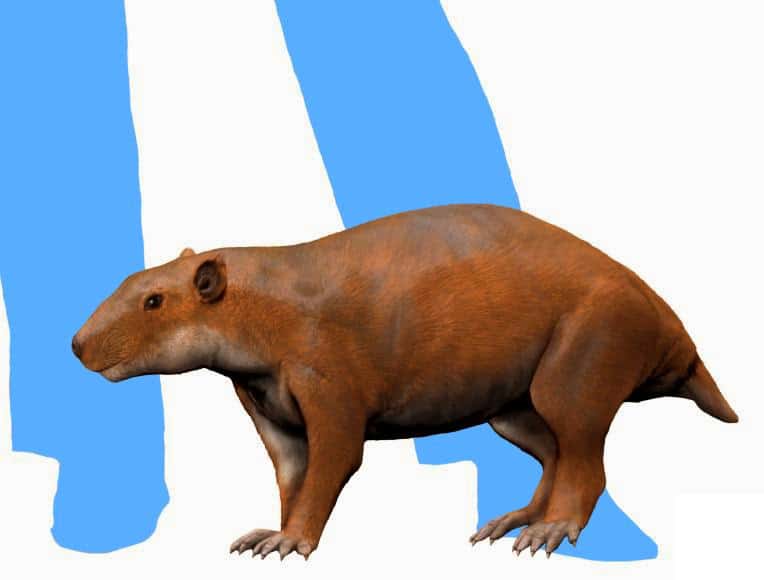
lived around 72 to 66 million years ago during the Upper Cretaceous.
©https://commons.wikimedia.org/wiki/File:Vintana_NT_small.jpg – License
2. Volaticotherium antiquus
Volaticotherium lived around 164 million years ago and was discovered in Inner Mongolia. It was a furry insectivore that was alive during the Jurassic period around 164 million years ago. The name Volaticotherium antiquus means “ancient gliding beast.”
This animal had arm wings that resemble those possessed by flying squirrels today. It could grab with its feet which is characteristic of tree dwellers. Volaticotherium antiquus was tiny and weighed up to a pound.
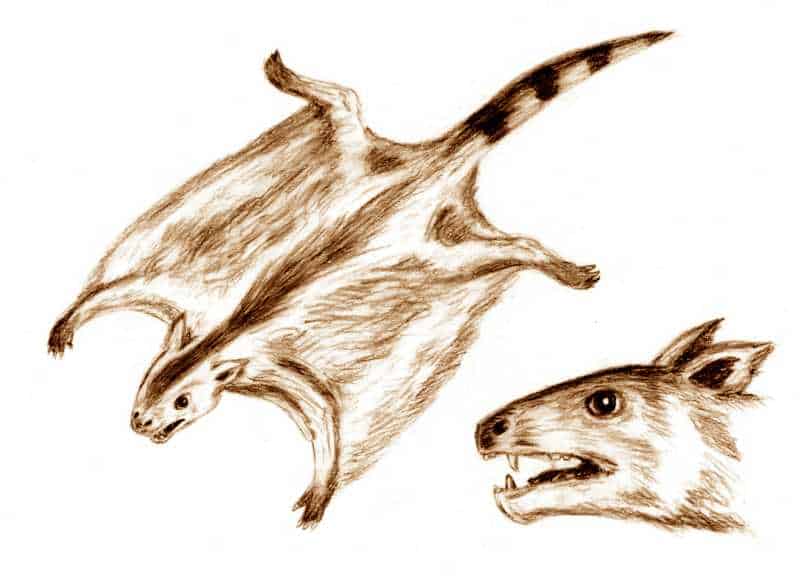
had arm wings that resemble those possessed by flying squirrels today.
©No machine-readable author provided. ArthurWeasley~commonswiki assumed (based on copyright claims)., CC BY-SA 3.0 <http://creativecommons.org/licenses/by-sa/3.0/>, via Wikimedia Commons – License
3. Liaoconodon hui
Liaoconodun hui was a mammaliaform that thrived during the Late Jurassic period. It was a glider that adapted independently around the same time as other winged mammaliaforms.
Almost all modern mammals have three ear bones that aren’t attached to anything. The ancient Liaoconondon had three ear bones, but they were connected to their jaw with cartilage. Before ear bones evolved into what they are today, they started as jaw bones that the ancestor of both mammals and lizards possessed.
4. Juramaia
Juramaia lived during the Middle and Late Jurassic and was found in northeastern China. They were little shrew-sized mammals that ate insects.
Juramaia is the first therian. Therians are a branch of animals that contains only placental and marsupial mammaliaforms.

were little shrew-sized mammals that ate insects.
©Nobu Tamura http://paleoexhibit.blogspot.com/ http://spinops.blogspot.com/ http://www.palaeocritti.com, Carnivorousfungi, CC BY-SA 3.0 <https://creativecommons.org/licenses/by-sa/3.0>, via Wikimedia Commons – License
5. Microdocodon gracilis
The Microdocodon gracilis was the first mammaliaform to suckle. It was an archaic mammal from the Jurassic period. Having the proper throat bone for milk consumption shows that the ability to drink milk evolved early.
Mammals are the only animals to suckle milk in infancy. The Microdocodon gracilis fossil that was found is the first example of a hyoid bone in mammals. Hyoid bones allow for the complicated throat and tongue movements required for sucking.
They were tiny shrew-sized animals that weighed less than a quarter of an ounce. It was an insectivore that lived in trees.
6. Repenomamus giganticus
Repenomamus giganticus was a carnivore that ate both dinosaurs and mammals. A fossil showed that it had eaten a baby dinosaur called Psittacosaurus. It’s unclear if this animal hunted little dinosaurs or if it just scavenged their remains.
They lived during the Early Cretaceous in China around 125 million years ago. It was the largest mammal of the Mesozoic era and was the size of today’s coyotes.
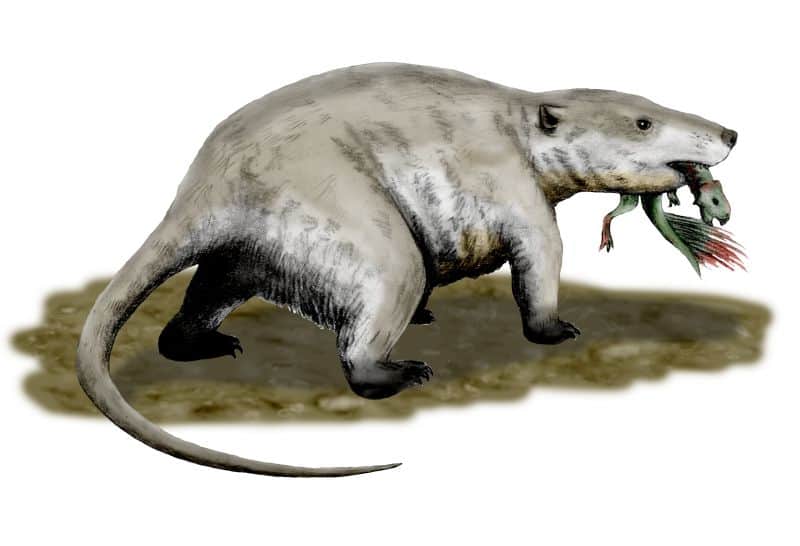
was a carnivore that ate both dinosaurs and mammals and was roughly the size of today’s coyote.
©Nobu Tamura (http://spinops.blogspot.com), CC BY 3.0 <https://creativecommons.org/licenses/by/3.0>, via Wikimedia Commons – License
7. Maiopatagium furculiferum
This mammal lived around 160 million years ago during the Jurassic in what is now northeast China. It had a membrane that acted like a gliding wing which shows it was one of the first flying mammals.
It probably glided to access food high off of the ground and to avoid being prey. It grew up to 9 inches in length and had long fingers.
These small primitive flying mammals are not related to extant bats. Maiopatagium furculiferum and its contemporaries independently developed the ability to fly. The animals that led to bats evolved flight separately over 100 million years later.
8. Vilevolodon diplomylos
This animal was alive around 160 million years ago during the Middle Jurassic. It’s one of the earliest examples of winged mammals along with Maiopatagium furculiferum. It was about the size of a mouse.
It had a jaw in evolutionary flux. The bones that become the three ear bones of modern mammals are still associated with the jaw but not dedicated to the jawbone. They perform both tasks related to chewing and hearing.
9. Agilodocodon scansorius
This mammaliaform was alive during the Middle Jurassic. Its teeth suggest that it was a small insectivore that was about the size of a shrew. It was about 5 inches in length and weighed just under an ounce.
It was a mammaliaform that spent a lot of time climbing trees. It looked like a long-nosed squirrel that adapted to swift movement in arboreal environments.
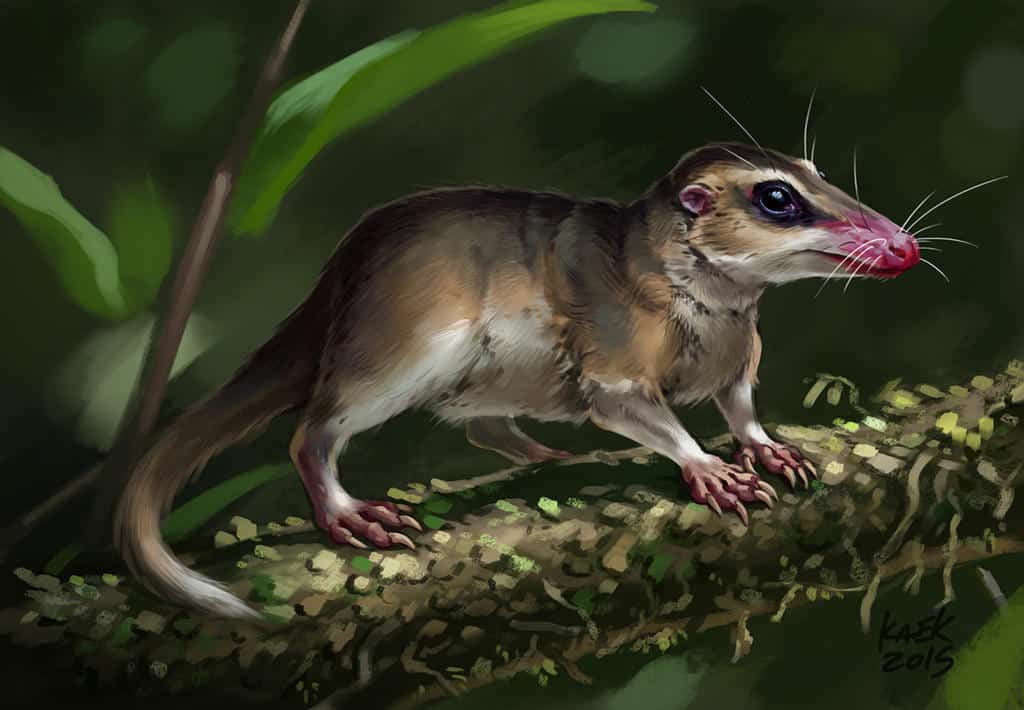
was a mammaliaform about the size of a shrew that spent a lot of time climbing trees.
©Kaek, CC BY 3.0 <https://creativecommons.org/licenses/by/3.0>, via Wikimedia Commons – License
10. Castorocauda lutrasimilis
Living in Inner Mongolia, this placental animal was adapted to the water. It had a similar skeletal structure to extant river otters and beavers. It was alive during the Middle to Late Jurassic.
The discovery of this animal blew the lid off of the old idea that mammals barely eked by in a primitive form until the disappearance of the dinosaurs. In reality, the Middle Jurassic hosted an explosion of different types of mammals. Most of these diversified mammals went extinct with the dinosaurs.
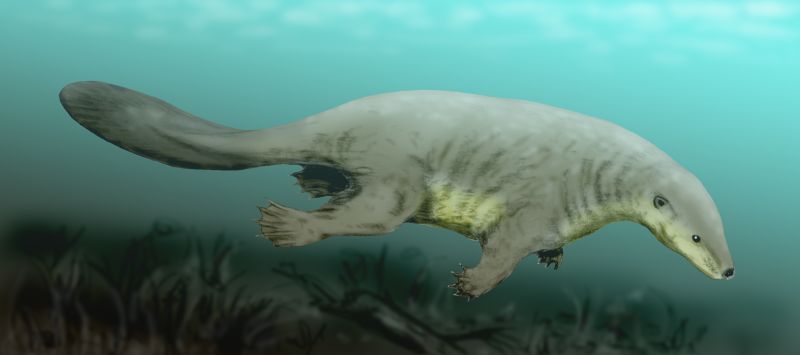
was adapted to the water with a similar skeletal structure to extant river otters and beavers.
©Nobu Tamura (http://spinops.blogspot.com), CC BY 3.0 <https://creativecommons.org/licenses/by/3.0>, via Wikimedia Commons – License
11. Purgatorius
Purgatorius was a mammal that existed around the time of the mass extinction event that led to the demise of all non-avian dinosaurs. While these early mammals weren’t around to see dinosaurs flourish, they were most likely present as the last of them died.
Purgatorius lived in North America and fossils have been found in Montana and Saskatchewan in Canada. So far, at least two distinct species have been discovered. Their names are Purgatorius titusi and Purgatorius unio.
This omnivorous animal was small and it’s most likely the oldest relative of extant primates. It fed on insects and fruits found at the top of trees. The forest canopy was probably their home.
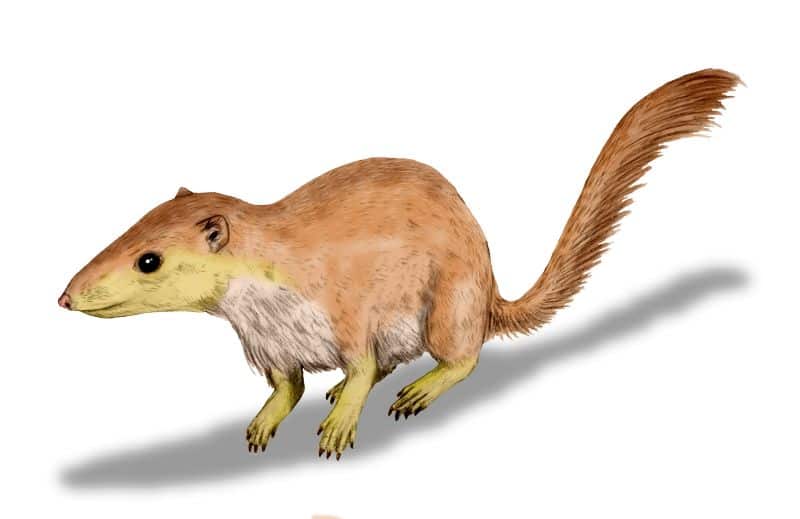
lived in North America and fossils have been found in Montana and Saskatchewan in Canada.
©Nobu Tamura, CC BY 3.0 <https://creativecommons.org/licenses/by/3.0>, via Wikimedia Commons – License
Summary of 11 Ancient Mammals that Lived Alongside Dinosaurs
| Number | Mammals |
|---|---|
| 1 | Vintana sertichi |
| 2 | Volaticotherium antiquus |
| 3 | Liaoconodon hui |
| 4 | Juramaia |
| 5 | Microdocodon gracilis |
| 6 | Repenomamus giganticus |
| 7 | Maiopatagium furculiferum |
| 8 | Vilevolodon diplomylos |
| 9 | Agilodocodon scansorius |
| 10 | Castorocauda lutrasimilis |
| 11 | Purgatorius |
What Modern-Day Mammals Are in Danger of Extinction?
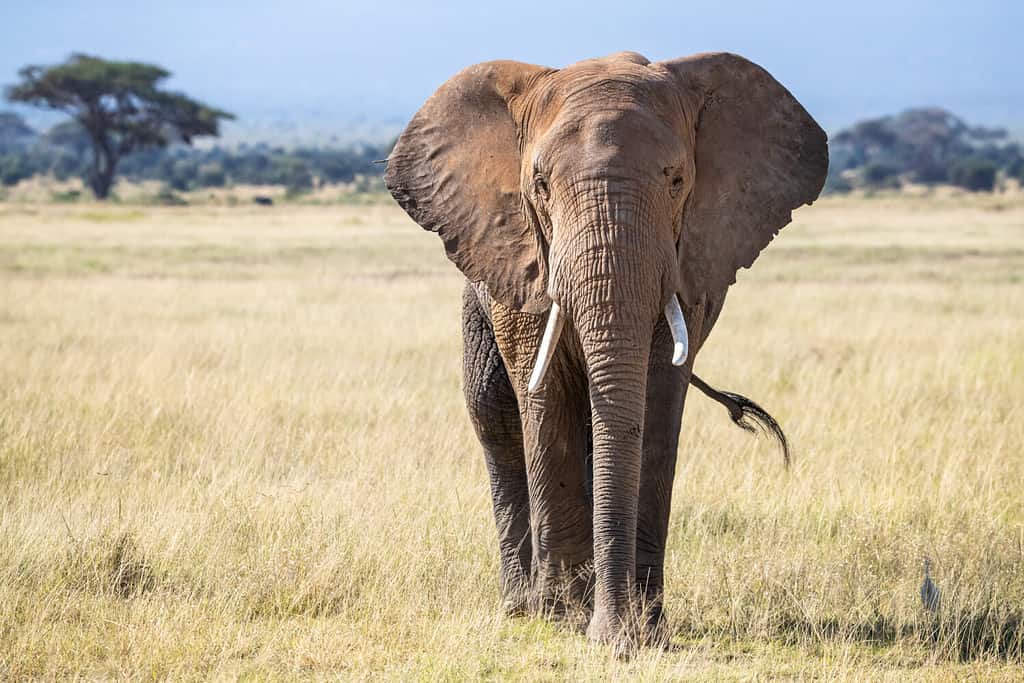
Earth’s largest land mammal, the
elephant
, is in danger of extinction.
©Jane Rix/Shutterstock.com
As we’ve discovered, there were some fascinating mammals that lived alongside dinosaurs in ages past. Unfortunately, there are many animals under threat of extinction today. Overall, the IUCN has listed 5,766 different animal species as endangered. The criteria for a species to be added to the endangered list are as follows:
- Population reduction–A taxon’s population is reduced by 50-70% due to certain factors defined by the IUCN
- Geographic Reduction–The specie’s extant area is reduced to between 5,000 and 500 square kilometers
- Dangerously low number of adults–A taxon’s population only has 2,500 or fewer adults left
- Expected rapid decline
Below is a list of three of the largest mammal species that are currently facing extinction:
1. African Savannah (Bush) Elephant/African Forest Elephant/Asian Elephant
Elephants are the largest land mammals on Earth, and unfortunately, they are facing extinction. African forest elephant numbers have declined by over 86% in the past 31 years, while African savanna elephants have decreased by 60% over the last 50 years. Both cases have resulted from poaching and habitat loss. Meanwhile, Asian elephants are endangered due to habitat loss, fragmentation, and poaching. There are only an estimated 30,000 to 50,000 left in the wild. Currently, both African savannah and Asian elephants are listed as endangered, while African forest elephants are critically endangered.
2. Bengal Tiger/Siberian Tiger/Sumatran Tiger/Indochinese Tiger/Malayan Tiger/South China Tiger
Tigers are the largest cat species on the planet, but all 6 extant species are either endangered or critically endangered. Three species have gone extinct in the last 100 years: the Javan tiger (1970s), Bali tiger (1930’s), and Caspian tiger (2003). Tigers have faced the largest threat due to habitat loss and poaching (for their exotic coats, and in some places, consumption and use of other body parts for rituals, jewelry, and more).
3. Blue Whale
Blue whales are the largest animals on the earth, inhabiting the planet’s oceans. They were hunted in the past for their meat and blubber, to the point that their numbers dropped from an estimated 200,000 in the 1800s to 20,000 today. They are listed as endangered by the IUCN. Currently, their greatest threat is global warming.
The photo featured at the top of this post is © Warpaint/Shutterstock.com
Sources
- Wiley Online Library, Available here: https://onlinelibrary.wiley.com/doi/abs/10.1002/9781119179313.wbprim0037
- PALAEONTOLOGIA POLONICA, Available here: http://www.palaeontologia.pan.pl/PP67/Wible.pdf
- Cambridge University Press, Available here: https://www.cambridge.org/core/journals/journal-of-paleontology/article/abs/new-species-of-purgatorius-mammalia-primatomorpha-from-the-lower-paleocene-bear-formation-crazy-mountains-basin-southcentral-montana/5E95B96A560C9642D458780B3C7F2788
- Taylor Francis Onlinr, Available here: https://www.tandfonline.com/doi/abs/10.1080/02724634.2014.976129
Thank you for reading! Have some feedback for us? Contact the AZ Animals editorial team.






